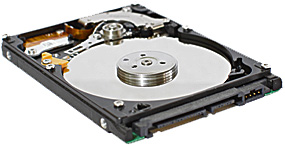 Question from Randy F.: My hard drive started making a combination of loud whining and clicking sounds last night.
Question from Randy F.: My hard drive started making a combination of loud whining and clicking sounds last night.
I did some research (thanks Google!) and found a forum post that said to run chkdsk to see if the drive has any bad sectors. It then said if bad sectors are found to run chkdsk/r to fix them.
I ran chkdsk and it did find a bunch of bad sectors. I started to run chkdsk /r to fix the bad sectors but then I remembered reading a follow-up post that said running chkdsk /r can kill a hard drive outright.
What’s your advice on this? I’d like to fix the drive and not have to replace it if that’s possible, but I don’t want to lose my pictures and other files by killing the drive. I need some advice on how to proceed.
Rick’s answer: Randy, I’m afraid I have to give you a bit of bad news. The whining and clicking sounds you’re hearing are tell-tale signs of a dying hard drive.
Your drive is going to go belly-up on you regardless of how you proceed from here. The only question is how long it will be before the drive stops working altogether.
To be blunt and straight to the point, “fixing” your hard drive isn’t a realistic option, and here’s why:
The components in modern hard drives are built to extremely close tolerances, and as their bearings and other components age with use they eventually start working outside those close tolerances.
When a bearing goes bad the platters can begin to “wobble” ever so slightly. This wobble can be so insignificant that you wouldn’t be able to detect it if you could somehow watch the platters as they spin.
The problem is, that imperceptible wobble could easily be enough to cause the heads to become misaligned over the data tracks on the platters.
As to the follow-up post stating that running chkdsk can kill a failing hard drive outright, that is absolutely true. Running chkdsk exercises a hard drive more than what it experiences in normal use, and just that small extra bit of work can cause a failing drive to stop working completely.
My advice to you is this:
1 – If you don’t have a backup of your photos and other files (and apparently you don’t based upon the info you provided) you need to make one immediately.
If you have an external USB hard drive you can create a System Image backup that will allow you to get back up and running quickly after installing a new hard drive.
These posts give step-by-step instructions for creating System Image backups in Windows 7, 8.1 and 10. Just read the post that corresponds to your version of Windows.
If you don’t have an external USB hard drive, I recommend that you shut your PC down and stop using it until you can get one. After you have the external drive on hand, power the computer back up and create the backup.
If you don’t plan to replace the bad hard drive with a new one, you can simply copy all of your photos and any other files you don’t want to lose onto the external drive and be done with it. That way you can copy them onto your new PC after you get it.
2 – If you want to keep using this computer instead of replacing it with a new one, you can purchase and install a new internal hard drive (or even better, replace it with a solid state drive (SSD)!) and restore your Windows installation and other files from the backup that’s now stored on your external drive.
Bottom line: Running chkdsk on a failing hard drive can potentially cause more harm than good. I recommend that you simply back up the data on your failing drive and then replace it with a new one.
Like this post? If so, I hope you’ll consider sharing it with your friends.
And by the way, you can get even more tips in my weekly RicksDailyTips Email Newsletter. Sign up for free at the bottom of this page!
Do you have a tech question of your own for Rick? Click here and send it in!